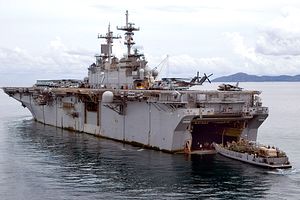The U.S. Navy and Marine Corps do not have enough amphibious assault ships to conduct full-scale combat operations in the Asia-Pacific region, according to a retired senior U.S. military official quoted in National Defense Magazine.
“Shipbuilding — we never get it right. … We need to start getting it right,” retired Marine Corps Lieutenant-General Thomas Conant, the former deputy commander of the U.S. Pacific Command, told an audience during a panel discussion in Washington, D.C., National Defense Magazine reports.
The reason is simple. The U.S. Navy’s fiscal year 2016 30-year shipbuilding plan does not take into account the U.S. Navy’s and Marine Corps’ capability requirements for executing an “opposed amphibious assault” with two Marine expeditionary brigades (each brigade consists of roughly 14,000 men) in the event of war.
According to U.S. Navy plans, conducting such combat operations would require a fleet of 38 vessels rather than the 30 amphibious assault ships currently in service. However, due to fiscal constraints, the navy compromised, requesting a mere 34 ships in the latest 30-year shipbuilding plan.
“If 38 ships is the requirement … in the most engaging and most hard-to-fight plan, then that’s a reality. It’s not just a Marine Corps requirement. It’s a requirement for the nation and we ought to think about how we’re going to approach that,” Conant stated.
While the difference between 38 and 34 ships seems negligible, one of the consequences, among other things, is that the Marine Corps will face difficulties in the future to adequately train for all of the different types of missions that it might need to perform over the next years in the Asia-Pacific.
Conant noted that other ships (such as maritime prepositioning vessels) could be used to substitute for amphibious assault ships in, for example, disaster relief operations or other peaceful engagements. However, during combat operations “you better have your amphibious capability,” he emphasized.(Maritime prepositioning ships have no defensive capabilities.)
Fewer available ships also result in longer deployment cycles, which is ultimately not sustainable because they wear out both ships and personnel, as Eric Labs, an analyst with the Congressional Budget Office, noted.
“The Navy recognized that this cannot go on forever and will be moving the amphibious force to the optimized fleet response plan, which is a cycle of 36 months to include a seven-month deployment,” he said. However, this new fleet response plan will additionally limit the number of ships available, according to Labs:
The amount of presence provided by the ships in San Diego will fall from about four today, which is nine months out of a 27-month cycle to a little more than two ships, which is seven months out of a 36-month cycle. You can’t maintain a second ARG [amphibious ready group] in the region with San Diego-based ships alone.
Yet, it is also not even certain that the U.S. Navy’s number of amphibious assault ships will, in fact, go up to 34 over the next few years, Labs emphasized:
[The] plan outlines a shipbuilding plan that is more expensive than what the Navy has received historically each year for the past 30 years. The Navy shipbuilding plan, as projected … would look to need $19 billion to $21 billion a year every year for the next 30 years.
The long-range naval battle force construction plan, if followed, would only foresee a fleet of 34 amphibious ships in the year 2022–six years from now. Also, according to Labs:
Amphibious ships are not the highest priority in the Navy or in Congress. New ballistic missile submarines are the Navy’s highest priority by the leadership’s own statements and that’s going to represent a very large amount of resource demand going forward from the early 2020s into the mid-2030s.
No other country in the world possesses a force of 30 amphibious assault ships, some of which are the size of other countries’ aircraft carriers (See: “US Navy Builds Largest Ever Amphibious Assault Ship for F-35 Fighters”). All in all, the U.S. Navy currently operates 272 ships – the largest and most powerful naval force in the world–and structured around its ten aircraft carrier strike groups.
The reason for the ostensible shortage of ships, next to a demanding forward deployment schedule, is an ambitious U.S. war plan which calls for the decisive defeat of an adversary in one region, while denying “ the objectives of—or impose unacceptable risk on—a second aggressor in another region.” The three regions the U.S. Navy is currently forward deployed to are the Pacific, the Mediterranean and Europe, and the Indian Ocean/Middle East.
Given current fiscal realities, perhaps it is then time to revise naval battle plans. This, however, will be unlikely as long as a large portion of D.C. policymakers and Pentagon officials are affected by the “Gathering Storm Syndrome” (See: “What Hawks Have to Say About the US Navy’s New Maritime Strategy”), which is partially fueled by China’s growing naval power and Russia’s ambitious rearmament plans.

































